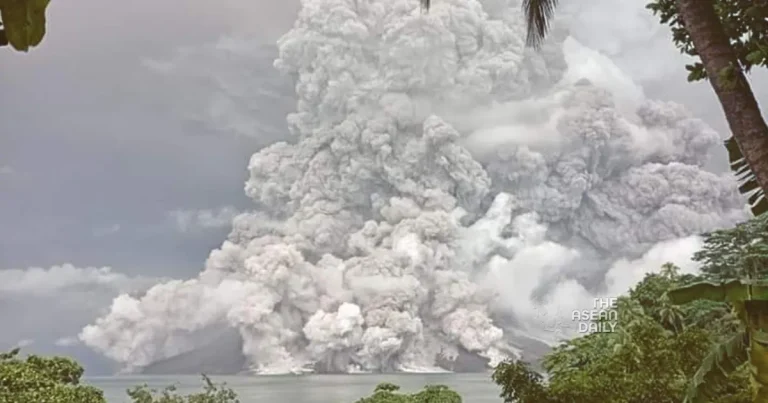1-5-2024 (JAKARTA) Mount Ruang, an active volcano on the Indonesian island of Sulawesi, erupted violently for the second time in a fortnight on Tuesday, belching a massive plume of ash almost 2 kilometres skyward. The powerful explosive event showered surrounding towns with debris and forced authorities to raise the hazard warning to its maximum level, prompting the closure of a major airport amid concerns over reduced visibility.
The 725-metre stratovolcano, situated some 95 kilometres northeast of Manado – the capital of North Sulawesi province – began exhibiting heightened volcanic tremors and activity earlier in the day, according to the nation’s geological agency. Monitoring sensors detected the escalating unrest, prompting the agency to elevate the alert status to its top tier while instructing residents and climbers to remain at least 6 kilometres away from the crater’s rim.
Ambar Suryoko, the regional airport authority chief, confirmed that Sam Ratulangi International Airport in Manado was temporarily shuttered Tuesday morning due to the potential threats posed by the drifting volcanic ash cloud to aircraft visibility and engines. The ashfall from Mount Ruang soon began raining down a gritty, abrasive carpet across towns and urban areas in the vicinity.
In Manado itself, a city of over 430,000 residents, the eruption plunged the daytime into an eerie semi-darkness as motorists were forced to switch on their headlights to navigate the ash-shrouded streets. “It was dark with rocks raining at the post from the eruption,” recounted Yulius Ramopolii, head of the Ruang monitoring outpost. “The vibrations were intense and knocked out power, and volcanic earthquakes shook the glass windows and everything around us.”
Ramopolii added that the towering eruption plume had effectively blocked out the sun’s rays while burying several villages in the vicinity under a thick blanket of falling volcanic debris. No casualties have been reported so far from Tuesday’s event.
The latest eruption follows an initial blast from Mount Ruang on April 17th that had prompted over 11,000 residents to evacuate amid warnings that a major explosive event could potentially trigger a tsunami by discharging volcanic material into the sea. While most have since returned home after the government downgraded the alert level, the Indonesian geological agency has now cautioned those living along coastal areas – particularly on the nearby island of Tagulandang – to remain vigilant for the dangers posed by pyroclastic flows reaching the ocean as well as tsunami threats from potential flank collapses.
As an archipelagic nation straddling the seismically-active Pacific Ring of Fire, Indonesia is routinely afflicted by volcanic eruptions of varying magnitude from its estimated 130 active volcanoes scattered across the sprawling island chain. The dramatic eruptions of Mount Ruang this month vividly illustrate the ever-present geologic hazards faced by communities situated in the shadow of the archipelago’s slumbering giants and the critical importance of robust monitoring and preparedness measures.




